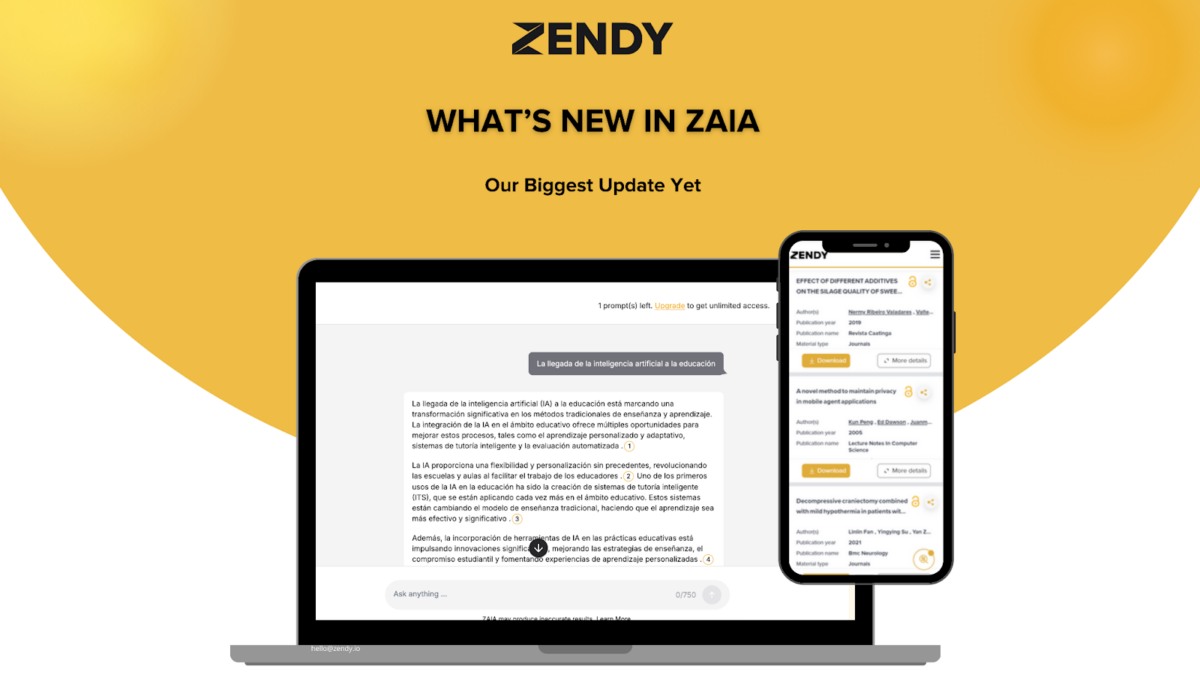We’ve rolled out one of the biggest updates to Zendy AI Assistant, ZAIA. These improvements focus on making research faster, more intuitive, and far more reliable.

Here’s what’s new.
Inline References You Can Trust
You no longer have to scroll, copy, or cross-check to figure out where an insight came from.
ZAIA now adds references directly inside its responses.
If ZAIA summarises a study, explains a concept, or pulls a fact from a paper, the source appears right there in the answer, clear, traceable, and easy to verify. It feels more like reading a well-cited academic explanation than an AI output.
Ask in Any Language, Get Answers in the Same Language
Whether you’re researching in Arabic, Spanish, French, or Swahili, ZAIA now responds in the language you use, automatically.
There’s no need to switch tools, tweak settings, or use separate translators. Just ask your question in your preferred language, and ZAIA replies in the same one.
It’s a smoother experience for multilingual classrooms, international research teams, and anyone working beyond English.
Search Smarter with the SOLR Agent
Sometimes you know the exact paper you need, you just don’t have the title, DOI, or permalink memorised.
Now you don’t have to.
ZAIA’s new SOLR Agent can search using:
- DOI
- Paper title
- A Zendy permalink
Just drop in any of these, and ZAIA fetches the correct paper instantly. It’s especially useful when you’re deep in a literature review and need to track down sources without losing your rhythm.
How does it work?
SOLR is the search engine behind ZAIA’s paper search.
It helps ZAIA find the exact research paper you’re looking for using clear identifiers like a DOI, paper title, or Zendy link.
Instead of guessing keywords or scanning long result lists, SOLR matches your input directly to the right paper, fast and accurately.
ZAIA Can Now Help With Your Zendy Account
You can now ask ZAIA about your subscription, billing questions, or common FAQs directly inside the platform.
No switching tabs.
No waiting for replies.
No digging through help pages.
ZAIA now serves as a support companion as well as a research assistant, especially helpful when you want quick answers in the middle of studying or writing.
A Clearer, More Transparent UI
One of the most noticeable upgrades is the updated interface.
You’ll now see clearer “thinking” steps that show how ZAIA processes your request.
It’s more transparent, easier to follow, and gives you a better sense of how ZAIA arrives at each answer, something many researchers have been asking for.
Why These Updates Matter
Every improvement in this update has one goal: to make research smoother and more trustworthy.
Whether you’re analysing papers, fact-checking a claim, working across languages, or sorting out your subscription, ZAIA is now better at supporting the full research journey.
And we’re not done.
This update is part of a larger shift toward a more personal and adaptive ZAIA, one that learns from how each researcher works.
For now, we hope these updates make your experience on Zendy faster, clearer, and more enjoyable.
If you’d like to see these features in action, just open ZAIA, Zendy AI Assistant, and try them out.















